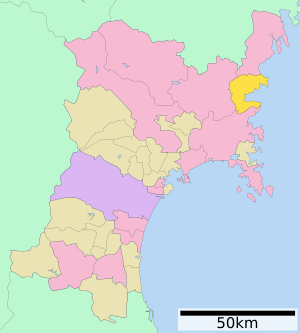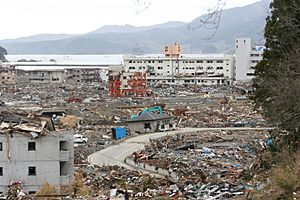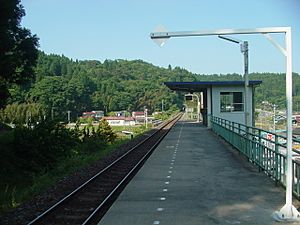Minamisanriku, Miyagi facts for kids

Minamisanriku (南三陸町, Minamisanriku-chō, "South three land"), also spelled Minami Sanriku, is a popular resort town. It is located by the Pacific Ocean in Miyagi Prefecture, Japan. The town covers an area of 163.74 square kilometres (63.22 sq mi). As of October 1, 2004, about 19,170 people lived there. Minamisanriku was created on October 1, 2005. This happened when the towns of Shizugawa and Utatsu merged.
Sadly, Minamisanriku was mostly destroyed by the Japanese 2011 tsunami. Most buildings were washed away by waves that were 16 metres (52 ft) or taller. More than half of the town's people went missing. They were almost certainly lost in the disaster.
Contents
The 2011 Tsunami Disaster in Minamisanriku
About 95 percent of Minamisanriku was destroyed. This happened during the 2011 Japanese tsunami. This huge wave followed the 2011 Tōhoku earthquake. Only the very tallest buildings were left standing. An estimated 9,500 people went missing. This was about half of the town's population. Around 9,700 people were confirmed to be alive. They were safely moved to other places.
The town had two special places for people to go. These were called evacuation centers. Residents could go there to escape from a tsunami. One center was on a hill overlooking the town. The other was further inland. Both were about 20 meters (66 feet) above sea level. However, the 2011 tsunami was so big that it covered them. Many people were swept away. At least 31 of the town's 80 planned evacuation spots were flooded by the tsunami.
Some early reports suggested that many residents went to the nearby city of Tome, Miyagi. An English teacher at the local high school shared what he saw. The school was on a hill above the tsunami. He said, "The entire town was simply swept away. It just no longer exists." He added that about 7,000 people were on his hill that day. A few thousand more were at another school on an opposite hill. But 17,000 people lived in the town. All the others were gone. Since the schools were on high ground, many children survived. But they became orphans. Survivors wrote "SOS" in white letters. They wrote it on the playing field of Shizugawa High school.
Mayor Jin Sato's Survival Story
When the earthquake hit, the town's mayor, Jin Sato (佐藤仁), was at a town meeting. They were talking about a smaller tsunami. This tsunami was caused by an earlier earthquake on March 9. The three-story building where the town's Crisis Management Department (防災対策庁舎, Bōsai Taisaku Chōsha) was located was covered by the tsunami. About 130 people worked in that building. Mayor Sato was one of only 30 people who made it to the roof. He was also one of only 10 who survived. He quickly returned to work. He started the disaster control center at the Bayside Arena on March 13, 2011.
Shizugawa Hospital and Miki Endo
Shizugawa hospital was one of the few big buildings that survived the tsunami. However, it was partly flooded. Sadly, 74 out of 109 patients died. Close to 200 people were rescued from the roof of the building.
Miki Endo (远藤未希) was a 25-year-old employee. She worked for the town's Crisis Management Department. She kept broadcasting warnings and alerts. She used a community loudspeaker system as the tsunami came in. Many people believe she saved many lives. The three-story headquarters of her department remained standing. But only its steel frame was left. All of the inside and walls were destroyed. After the disaster, Endo was missing. She was later found to have died. Photos show the building's roof completely underwater at the tsunami's highest point. Some people held onto an antenna on the roof to survive.
Past Tsunami Events in Minamisanriku
The Great Chilean Earthquake of 1960 caused a tsunami. This wave traveled across the Pacific Ocean. It hit the town of Shizugawa, which is now part of Minamisanriku. That tsunami was as high as 2.8 metres (9.2 ft). At that time, people thought the damage was very bad. Because of this, two-story-high harbor walls were built by 1963. Residents also practiced tsunami drills every year on the anniversary. However, these harbor walls did not help in the 2011 tsunami. That wave washed over buildings as tall as four stories.
To remember the 30th anniversary in 1990, a special plaque was put up. It was written in both Spanish and Japanese. It had a message from President Patricio Aylwin of Chile. A copy of a moai statue was also placed there. The plaque survived the 2011 tsunami.
The 2010 Chile earthquake also caused a 1.3-metre (4.3 ft) tsunami in Minamisanriku. This happened in 2010.
Getting Around Minamisanriku
The Kesennuma Line is a train line that serves Minamisanriku. It includes these stops: Rikuzen-Togura, Shizugawa, Shizuhama, Utatsu, and Rikuzen-Minato. The main roads in the area are Route 45 and Route 398.
See also
 In Spanish: Minamisanriku para niños
In Spanish: Minamisanriku para niños



